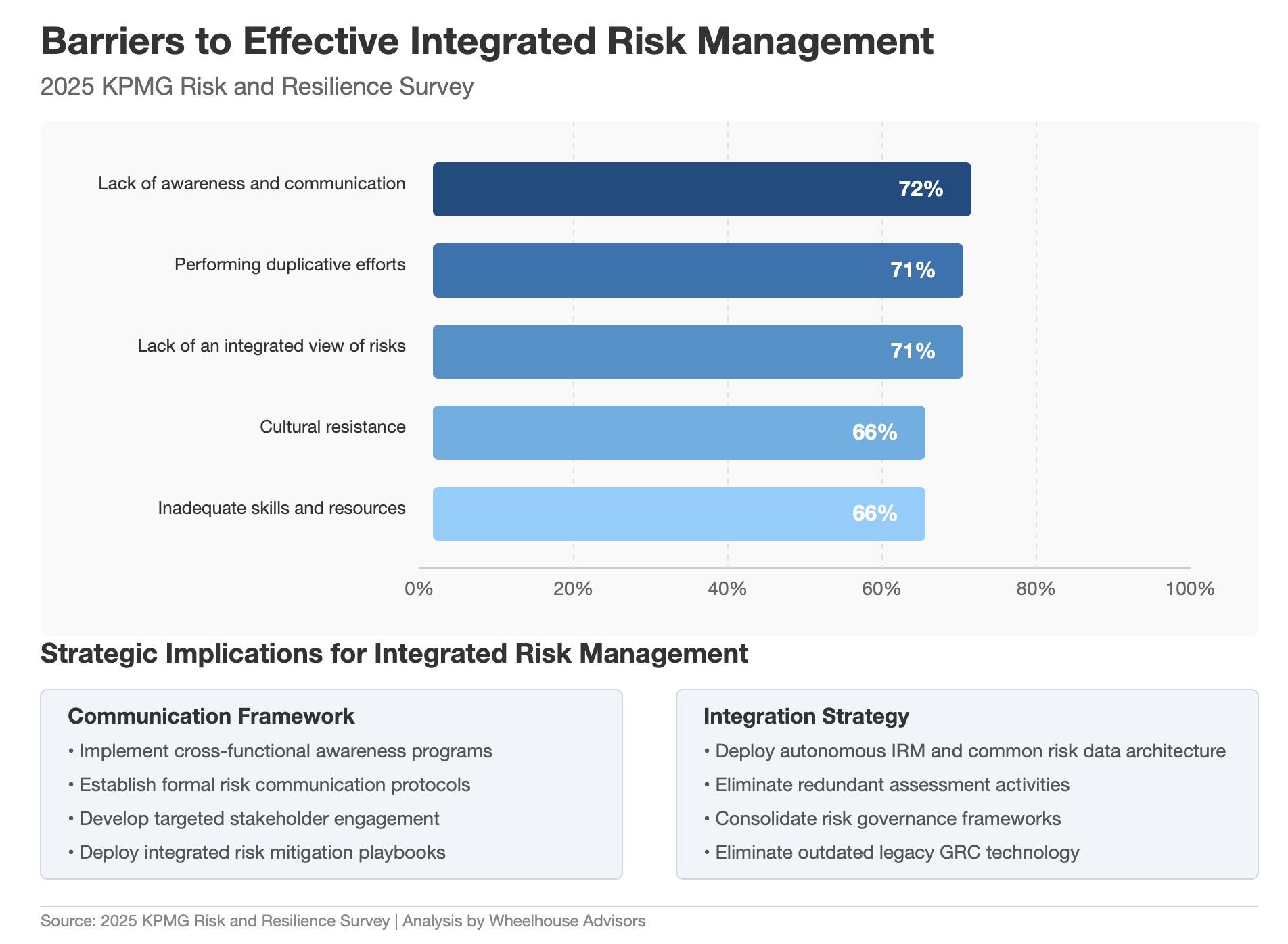Bridging the Resilience Gap: Why Integrated Risk Management Outperforms Legacy GRC Solutions
A recent KPMG Risk & Resilience Survey (March 2025) has revealed a concerning reality: most U.S. organizations remain unprepared to handle increasing risk events and broad disruptions. The report highlights that two-thirds to nearly three-quarters of organizations face moderate to strong barriers to managing risk effectively. These challenges include cultural resistance (66%), lack of an integrated view of risks (71%), and inadequate skills or resources (66%). These findings underscore a critical gap in how organizations manage risk and, more importantly, where traditional Governance, Risk, and Compliance (GRC) technologies fall short.
Despite heightened awareness of risk exposure, many organizations remain locked into outdated risk management models prioritizing compliance over strategic resilience. This limitation is particularly concerning given the rapid evolution of digital threats, regulatory complexities, and geopolitical uncertainties that demand a more dynamic risk framework. Without the ability to aggregate, analyze, and respond to risks in real time, organizations are left exposed to disruptions that can threaten business continuity and stakeholder confidence.
The Shortcomings of Legacy GRC Solutions
Historically, organizations have relied on standalone GRC tools to address risk management. While effective in isolated compliance and audit functions, these tools fail to offer a comprehensive, integrated view of enterprise-wide risks. The KPMG report confirms that risk functions often operate in silos, with duplicative efforts (71%) and a lack of coordination in risk and resilience planning (52%). As a result, many organizations struggle to align risk insights with strategic decision-making.
IRM: The Key to Breaking Risk Management Barriers
“KPMG’s latest survey highlights a growing risk gap—organizations recognize today’s complexities but struggle with siloed functions, duplicative efforts, and outdated approaches. This is driving the surge in demand for Integrated Risk Management (IRM). Unlike legacy GRC tools, IRM unifies risk data, enhances predictive insights, and embeds resilience into strategy. In an era of constant disruption, businesses that adopt IRM will lead the way.”
— John A. Wheeler, Founder & CEO, Wheelhouse Advisors
Traditional GRC platforms often emphasize compliance tracking and regulatory reporting rather than proactive risk identification and mitigation. With cybersecurity (57%), data privacy (43%), and technology risks (41%) being the top concerns for executives, it is evident that businesses require a more dynamic and forward-looking risk management framework—one that legacy GRC solutions simply do not provide.
Furthermore, as organizations expand their digital footprint, the sheer volume of risks has outpaced the capabilities of traditional GRC solutions. Legacy systems often lack the integration and automation capabilities to handle complex, interrelated risks spanning supply chains, cyber threats, and third-party partnerships. This lack of connectivity leads to reactive decision-making, increasing operational inefficiencies and amplifying vulnerability to external shocks.
The Case for Integrated Risk Management (IRM)
Integrated Risk Management (IRM) technology presents a superior alternative by offering a holistic, real-time approach to risk management. Unlike legacy GRC tools, IRM solutions consolidate risk data across enterprise functions, enabling organizations to:
Break Down Silos – IRM platforms integrate risk intelligence from cybersecurity, operational risk, compliance, and third-party risk, ensuring a unified and organization-wide approach. IRM fosters greater collaboration across departments and executive leadership by eliminating fragmented risk functions.
Enhance Predictive Capabilities – With advanced analytics, scenario modeling, and AI-driven insights, IRM helps businesses anticipate potential threats rather than react to them post-disruption. Predictive analytics and machine learning enable organizations to simulate risk events and proactively implement mitigation strategies.
Align Risk with Strategy – The KPMG survey revealed that only 64% of organizations integrate risk into strategic decision-making, leaving a significant gap. IRM enables leaders to embed risk considerations into business strategy, ensuring resilience is a core operational principle. This alignment protects against potential threats and enhances operational agility and long-term sustainability.
Automate and Streamline Risk Processes – Modern IRM solutions leverage automation to reduce redundancy, enhance risk reporting accuracy, and free up resources for higher-value strategic initiatives. Automation ensures that risk assessment and compliance monitoring keep pace with evolving business landscapes, reducing human error and improving efficiency.
Ensure Regulatory Agility – With evolving compliance mandates, an IRM approach offers flexibility in adapting to new regulations without needing multiple, disjointed systems. Organizations can continuously comply with evolving industry standards and regulatory frameworks by leveraging real-time updates and automated reporting.
Improve Stakeholder Confidence – By adopting an integrated approach to risk, organizations demonstrate a commitment to transparency and resilience, strengthening investor, customer, and regulatory trust. Businesses that proactively manage risk mitigate potential disruptions and differentiate themselves as industry leaders in risk governance.
The Path Forward: Modernizing Risk Management
As the risk landscape grows increasingly complex, organizations can no longer afford to rely on fragmented, legacy GRC tools that fail to deliver a comprehensive risk posture. The KPMG Risk & Resilience Survey findings reinforce the urgent need for an integrated, data-driven approach to risk management—one that IRM technology uniquely provides.
Organizations that continue to rely on outdated, compliance-focused risk management strategies will find themselves increasingly vulnerable to disruptions that could have been anticipated and mitigated with an IRM approach. Forward-thinking businesses must recognize the competitive advantage of adopting a dynamic, technology-enabled risk management framework. IRM provides both a means of compliance and a strategic asset that enhances operational resilience, safeguards reputations, and ensures sustainable growth in an unpredictable business environment.
By adopting IRM, organizations can enhance resilience, strengthen decision-making, and gain a competitive advantage in an era of uncertainty. It’s time for businesses to move beyond outdated GRC models and embrace the future of risk management through an integrated, technology-driven strategy. The sooner organizations transition to IRM, the better positioned they will be to navigate the increasingly volatile and interconnected risk landscape of the future.

